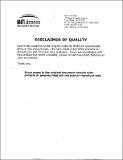Biological dosimetry of neutron beams for neutron capture therapies
Author(s)
White, Susan Marie, 1973-
DownloadFull printable version (16.86Mb)
Other Contributors
Massachusetts Institute of Technology. Dept. of Nuclear Engineering.
Advisor
Jacquelyn C. Yanch.
Terms of use
Metadata
Show full item recordAbstract
Boron neutron capture therapies using the 10B(n,a)7Li reaction have been proposed as treatments for glioblastoma multiforme, metastatic melanoma, rheumatoid arthritis, and other debilitating conditions. This thesis presents the first combined biological and physical dosimetry interbeam comparison data of three neutron beams used in boron neutron capture therapies: the Massachusetts Institute of Technology (MIT) and Brookhaven National Laboratory epithermal neutron beam facilities previously used in Phase I/II human clinical trials of boron neutron capture therapy (BNCT), and the boron neutron capture synovectomy (BNCS) facility at MIT. The biological dosimetry methodology developed included in vitro irradiation of rodent cells at various depths in a water-filled phantom that simulated healthy tissue. These experiments evaluated the biological effectiveness of the neutron and photon components since no boron was present. Cell survival at a given dose was dependent upon the depth in the phantom as a result of moderation and attenuation of the beam components by overlying water. Results were compared with 250 kVp X-ray irradiations to determine relative biological effectiveness (RBE) values of the beams; neutron RBE values were calculated from the beam RBE values.
Description
Thesis (Ph. D.)--Massachusetts Institute of Technology, Dept. of Nuclear Engineering, 2001. Includes bibliographical references (leaves 161-167).
Date issued
2001Department
Massachusetts Institute of Technology. Department of Nuclear Engineering; Massachusetts Institute of Technology. Department of Nuclear Science and EngineeringPublisher
Massachusetts Institute of Technology
Keywords
Nuclear Engineering.